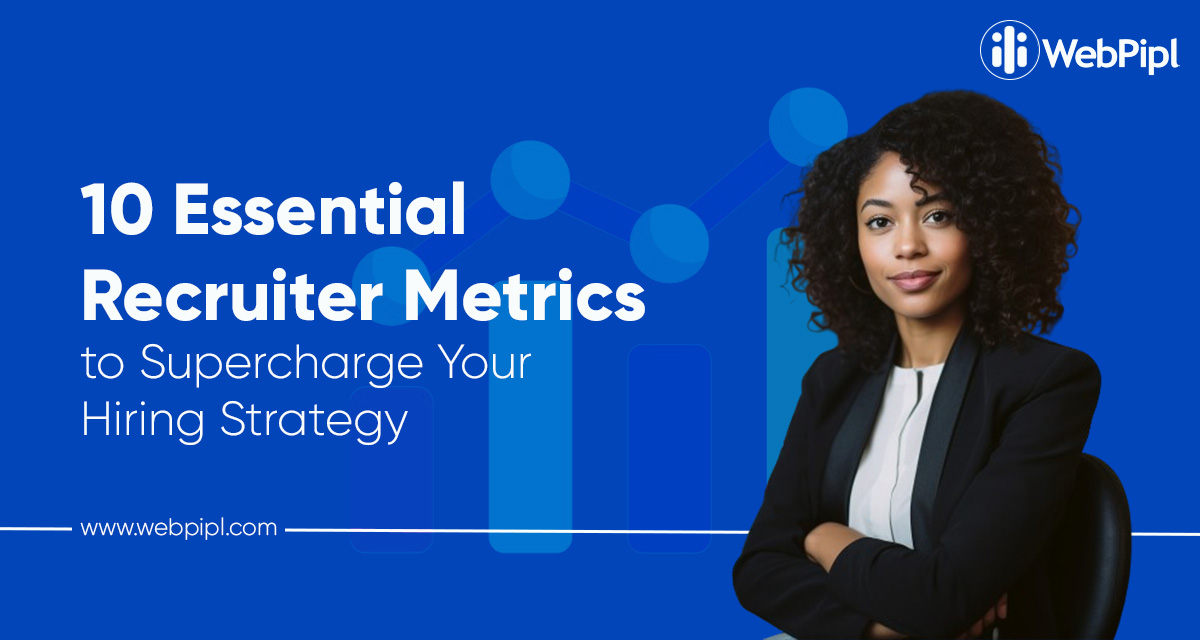
In today’s talent-driven market, attracting and retaining top talent is crucial for organizational success. But how do you know if your recruitment efforts are hitting the mark? This guide delves into 10 essential recruiter metrics, empowering you to optimize your hiring process and supercharge your talent acquisition strategy.
Efficiency Metrics: Finding the Right Fit, Fast
1. Time to Fill:
This metric reveals the average number of days it takes to fill an open position. Aim for a sub-45-day timeframe to streamline your process and minimize costs.
Formula: Time to Fill = Date of Hire – Date of Job Posting
Example: If it takes an average of 60 days to fill open positions, you could implement strategies like targeted sourcing and efficient interview scheduling to reduce this to 40 days, saving time and resources.
2. Time to Hire:
This metric tracks the average number of days a candidate spends within your hiring process. Aim for a sub-30-day timeframe to ensure a smooth and positive candidate experience.
Formula: Time to Hire = Date of Offer Accepted – Date of Initial Application
Example: If your average time to hire is 45 days, identify bottlenecks like lengthy interview rounds or delayed feedback. Streamlining the process could reduce this to 25 days, improving candidate experience and engagement.
3. Applicants per Opening:
This metric gauge the level of interest generated by your job postings. Aim for at least 20 qualified applicants per opening to ensure a good pool of candidates.
Formula: Applicants per Opening = Total Applicants / Number of Openings
Example: If you receive only 10 applications for a position, consider revising your job description for clarity or exploring different sourcing channels to attract a wider range of qualified candidates.
4. Selection Ratio:
This metric reflects the number of interviewed candidates compared to those offered the job. Aim for a ratio between 3:1 and 5:1.
Formula: Selection Ratio = Number of Interviewed Candidates / Number of Offers Made
Example: If your selection ratio is 8:1, you might be interviewing too many unqualified candidates. Refine your screening process or adjust your job requirements to attract a more targeted pool.
5. Cost per Hire:
This metric tallies the total expenses associated with hiring someone, from advertising to onboarding. Aim for a cost per hire that aligns with your industry benchmarks and budget.
Formula: Cost per Hire = Total Hiring Costs / Number of Hires Made
Example: If your cost per hire is significantly higher than the industry average, analyze your sourcing channels, advertising costs, and interview process to identify areas for cost optimization.
Effectiveness Metrics: Hiring the Right People
1. Quality of Hire:
This metric measures the performance and contribution of new recruits. Track metrics like retention rates, productivity levels, and performance reviews to assess their impact.
Formula: Quality of Hire = Metrics reflecting new hire performance (e.g., retention rate, productivity)
Example: If a high percentage of new hires leave within the first year, you might need to improve your job descriptions, interview process, or onboarding program to ensure a better fit.
2. Offer Acceptance Rate:
This metric reveals the percentage of candidates who accept your job offer. Aim for an acceptance rate of at least 70%.
Formula: Offer Acceptance Rate = Number of Offers Accepted / Number of Offers Made
Example: If your offer acceptance rate is low, analyze your offer details, gather candidate feedback, and refine your approach to make more competitive offers and create a positive candidate experience.
3. Source of Hire:
This metric identifies the most effective channels for attracting qualified candidates. Track where your best hires come from and allocate resources accordingly.
Formula: Source of Hire = Source Channel where best hires were found
Example: If most of your best hires come from employee referrals, consider investing in referral programs and incentives to further leverage this successful channel.
4. Candidate Diversity:
This metric assesses the diversity of your applicant pool and new hires across various demographics. Aim for a diverse workforce that reflects the broader community.
Formula: Candidate Diversity = Metrics reflecting diversity of applicants and hires (e.g., percentage of women, minorities, etc.)
Example: If your workforce lacks diversity, implement inclusive recruitment practices, partner with diversity-focused organizations, and actively attract candidates from underrepresented groups.
Beyond the Numbers: Building a Holistic View
1. Hiring Manager Satisfaction:
This metric reflects how satisfied hiring managers are with the candidates presented to them. Regularly gather feedback to ensure they feel involved and confident in the process.
2. Candidate Experience:
This metric captures how candidates perceive their interactions with you.
Conclusion: Your Data-Driven Path to Recruitment Excellence
By embracing these 10 essential recruiter metrics, you unlock a data-driven roadmap to optimize your hiring process and attract top talent. Remember, the most valuable metrics will vary based on your specific company, industry, and hiring needs. The key is to consistently track, analyze, and use these insights to:
- Identify areas for improvement: Are your interviews taking too long? Are you attracting enough qualified candidates? Are your new hires thriving in their roles?
- Implement targeted changes: Streamline your interview process, refine your job descriptions, or invest in employee referral programs based on your findings.
- Build a holistic view: Consider hiring manager satisfaction, candidate experience, and diversity alongside efficiency and effectiveness metrics.
- Continuously adapt and evolve: The talent landscape is dynamic, so stay informed about industry trends and adjust your metrics and strategies accordingly.
As you embark on this data-driven journey, remember that metrics are tools, not absolutes. Use them to guide your decisions, measure progress, and ultimately build a high-performing team that fuels your organization’s success. By embracing data and a commitment to continuous improvement, you can confidently navigate the competitive talent landscape and attract the best and brightest minds to your organization.

Raju Thammala is the founder of WebPipl, an AI-based recruitment company revolutionizing the tech hiring process with products like video interviews, ATS software, etc.
As CEO and founder, Raju Thammala is passionate about leveraging technology to deliver next-gen recruiting services. In his free time, Raju enjoys reading and exploring new cuisines or jet-setting to exotic destinations.
